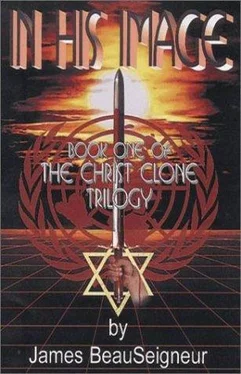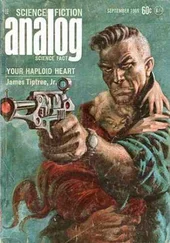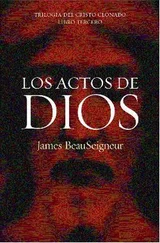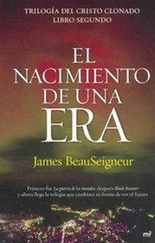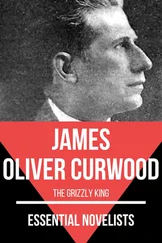Decker moved the slide around on the stage, refocusing as necessary. "There's not much there," he said, still scanning the slide.
"Exactly," Goodman said. "At first I was rather disappointed. I checked the grid but the only other samples from the feet, were from the nail wounds in the right foot." Goodman took the slide from the microscope and carefully placed it back in its designated slot.
"You remember that the right foot actually had two exit wounds, indicating that the feet had been nailed left over right. The right foot was nailed down first, with the nail exiting through the arch of the foot. The left foot was then nailed on top of the right with the nail passing through both feet, leaving an exit wound in the arch of the left foot and the heel of the right. Neither of these samples seemed very promising though, because any dirt that had been in the wound areas would likely have been bonded to the cloth by the blood."
Goodman took a second slide from the plastic case. "This particular sample is from the blood stain of the right heel. I really didn't expect to find any dirt there, but I looked anyway." Goodman paused.
"That's when I found it."
Goodman reached around Decker and shut off the microscope's lamp and handed him the slide. Decker took the slide and placed it on the microscope's stage. He adjusted the mirror to compensate for the loss of light from the lamp and focused the lens. Goodman rotated the objective to [??]SOftY. On the slide before him, Decker could see a group of several strangely familiar disk-shaped objects surrounded by and imbedded into crusty blackish-brown material that he assumed to be blood.
After a moment, he looked up at Goodman. His eyes had grown wide and his mind raced in disbelief and confusion. "Is that possible?" he asked finally.
Goodman opened a large medical text book to a well marked page and pointed to an illustration in the upper left corner. What Decker saw there was an artist's representation of something very similar to what he had just seen through Goodman's microscope. The caption below the picture read, "human dermal skin cells."
Decker looked back through the microscope to be sure. Inexplicably, despite hundreds or even thousands of years, they appeared to be perfectly preserved. He felt Goodman reach around him again, this time to turn the lamp back on. The brighter light made the small disks appear transparent and Decker could clearly see the nucleus of each cell. Within a few seconds the lamp began to gently warm the slide. Decker looked away to rub his eyes and then looked back.
In the warmth of the artificial light, the nuclei began to move.
Mother of God
Decker's chest felt heavy and his head light. He struggled to catch his breath. Silently he watched the nuclei of the cells as they continued to undulate. His mind seemed to float in the sea of warm cytoplasm before him, void of points of reference except for the cells. A thousand questions rose and fell, fighting for his attention, but he was incapable of enough focus on anything outside of what he saw to even realize his confusion. It was only when he ceased his attempt to understand the full impact of what he was seeing, that his senses began to reemerge from the ooze. Decker's ears slowly became aware of Goodman's voice.
"Decker."
"Decker." Goodman touched him on the shoulder and finally he looked up. "Are you hungry?"
Decker hadn't eaten since breakfast, but right now he thought Goodman's question was insane.
"Believe me," said Goodman, "I know just how you feel. The same thing happened to me. I went looking for dirt and found live dermal skin cells. I nearly got religion! That's when I made the connection to Professor Crick's theory." Goodman took the slide from the microscope and carefully placed it back in the plastic case.
"What is it?" Decker asked finally.
"I showed you," said Goodman. "They're dermal cells – cells from just below the skin's surface. Oh, and as you've obviously noticed, they're alive." Goodman hid the excitement he felt in finally being able to share his discovery, and his calm, understated response simply served to accentuate Decker's confusion.
"But what?… How?" Decker pleaded.
"The cells were picked up on the Mylar tape along with some small flecks of blood. Apparently when the Shroud was laid over the crucified man, some of the exposed flesh of the wound was bonded to the cloth by the dried blood. When the man was regenerated and the Shroud was pulled away from his body, a small amount of dermal material was pulled away with it. The same thing can happen when bandages are removed from a large wound. I suspect the weight of the heel resting on the cloth helped some, too. What you have just seen are cells at least six hundred years old with absolutely no sign of degeneration. In short: they're alive."
"Six hundred years?" Decker asked.
"Well, if the carbon 14 dating is correct, yes. On the other hand, I think it is rather unlikely that anyone would have been crucified in the thirteenth or fourteenth century. I have no real evidence to dispute the carbon 14 results but my guess is that, in all likelihood, the Shroud does date to the first century and was, in fact, the burial cloth of Jesus. The historical evidence is rather conclusive that Jesus did exist. I've never doubted that any more than I've doubted the historical evidence of Alexander the Great or Julius Caesar. Actually, it all fits perfectly into my hypothesis."
"Professor, why weren't the blood cells alive?" Decker asked.
"That's an interesting question. I assume it's because the blood is from the body that died. The skin cells, on the other hand, are from the body after it was regenerated."
Goodman put his hand on Decker's shoulder and gently nudged him in the direction of the door. "I don't know about you, but I'm starved and my housekeeper was expecting us half an hour ago for lunch. My wife is visiting her mother in Kansas City."
Goodman's house was an English Tudor with brown trim and stone on a quiet dead-end street about twenty minutes from the campus. The two men were greeted at the door by Goodman's housekeeper, a young Hispanic woman. "Maria, this is my guest, Mr. Hawthorne." Goodman spoke very slowly, enunciating every word. "We'll have our lunch now."
As Decker looked around the house it seemed that every wall had shelves full of books. A few shelves had additional books neatly stacked beside them. Decker had never met Goodman's wife, Martha, but she was obviously very tolerant of her husband's profession.
"Professor, we need to talk," Decker said as they sat down at the dining room table.
"Yes, I know," Goodman answered.
Decker's eyes glanced to the housekeeper and then back to Goodman.
"Oh, don't worry about her," Goodman said. "She hardly speaks any English. She's only been in this country about six months."
"We can't keep this to ourselves," Decker started.
"I have no intention of keeping it secret forever, but if we let the story out now there will be no end to the reporters. Not to mention the thousands of mindless religious kooks. You remember the crowds in Turin lined up to see the Shroud? What do you think would happen if word leaked out that live cells from the body of Jesus were in a laboratory in Los Angeles? Every sick or dying person in America would be here overnight hoping to touch the cells and be healed. I've touched the cells and they haven't done a thing for me. You may have touched them yourself, when you were handling the Shroud in Turin and I notice it hasn't stopped your hairline from receding," Goodman added in characteristic deadpan humor. "All that would result from releasing the story now is that a lot of people would be hurt. But if we wait until I've finished my research we may be able to offer some real healing power."
Читать дальше
